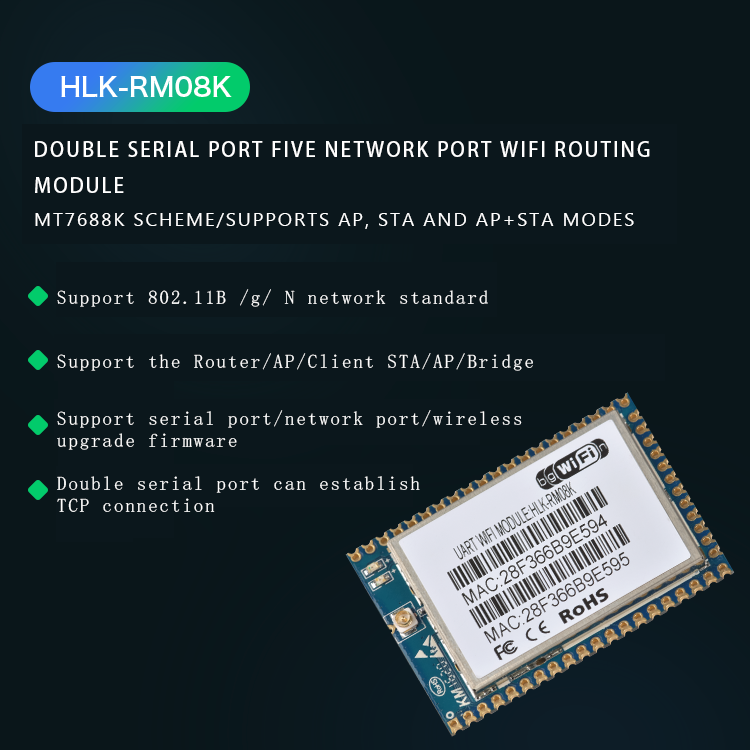
Product selection table
PRODUCT SELECTION TABLE
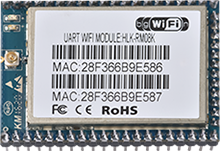
hlk-rm08k(Pin version)
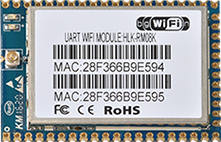
hlk-rm08k(The patch version)
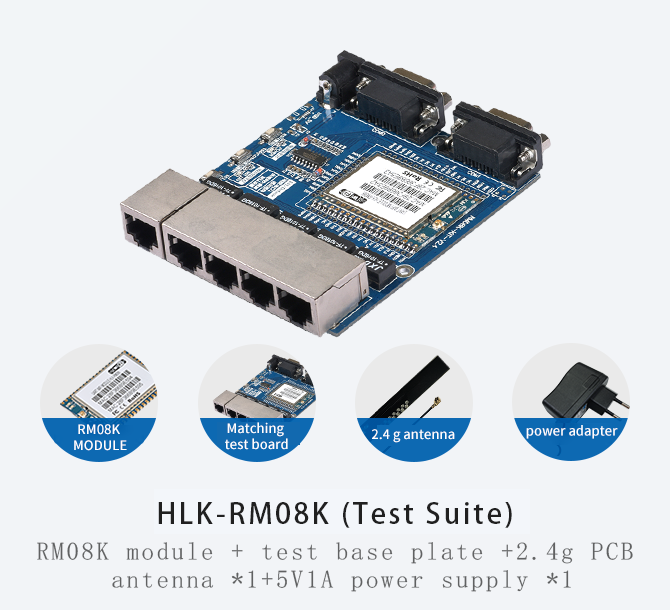
products description
PRODUCT DESCRIPTION
Hlk-rm08k is an embedded WiFi module based on universal serial interface conforming to network standards, with built-in TCP/IP protocol stack,
which can realize the conversion between serial port, Ethernet and WiFi interfaces
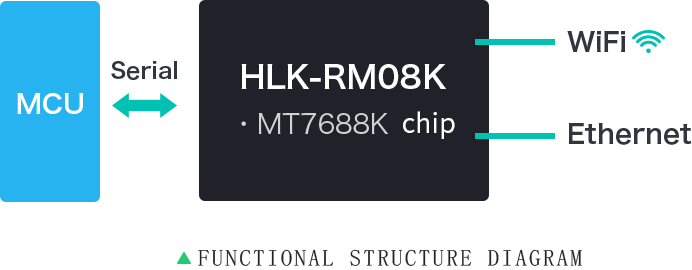
product size
PRODUCT SIZE
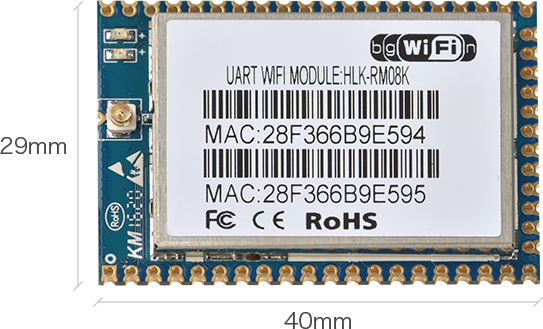
ModelHLK-RM08K(Insert version/patch version)
Model40*29*3.2mm
Chip TypeMT7688K
Carrier Frequency2.4GHz
ransmitted Power18dBm
Communication Distancehaul100m
Suttle4/6g
*The thickness of 3.2mm is the circuit board + shield
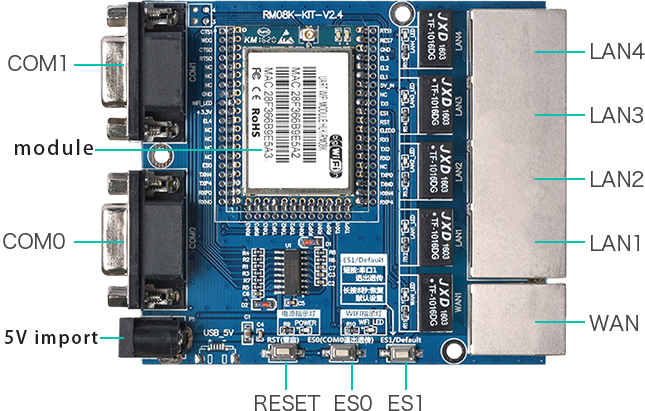
RM08K module + Functional test Base plate +5V1A power adapter + 2.4g antenna *1(Standard Kit)
ES0 function description:
1.After the normal start of the system, the time for ES0 to maintain low level is 0.05s< t< 6S, serial port 0 exit passthrough mode
2.After the system starts normally, ES0 keeps low level for 6S& LT; T< 12S, restore customer Settings
ES1 function description:
1.After the normal start of the system, ES1 kept low level for a time of 0.05s< t< 6S, Serial port 1 exits passthrough mode
2.After the system starts normally, ES1 keeps low level for 6S& LT; T< 12S, restore factory Settings
function declaration
FUNCTION DESCRIPTION
Product functions are divided into: default mode, serial port to Ethernet, serial port to WiFi STA, serial port to WiFi AP, serial port to WiFi CLIENT, and serial port to wired or wireless bridge
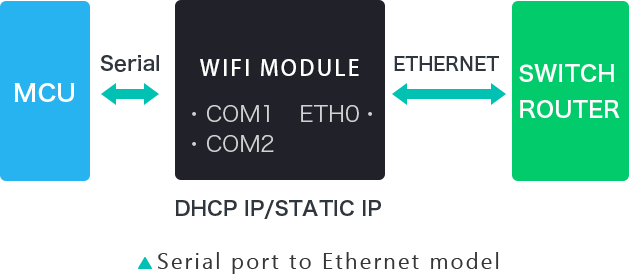
·In this mode, ETH0 enabled, eth1-4 turned off, WiFi function turned off;
·WiFi ·Ethernet can be configured as dynamic IP address (DHCP) or STATIC IP address (STATIC)。
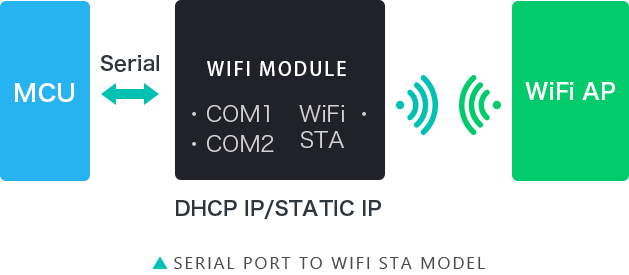
·Wireless network card mode, in this mode, WiFi enabled, work in STA mode, Ethernet port eth0-4 closed
·WiFi STA can be configured as dynamic IP address (DHCP) or STATIC IP address (STATIC)。
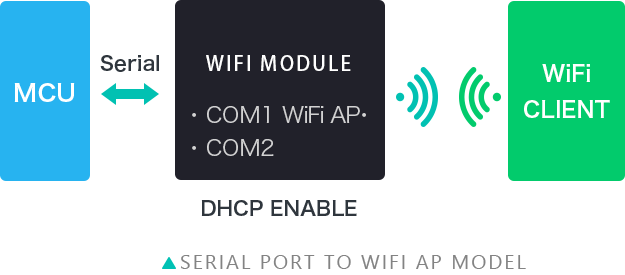
·WiFi enabled in AP mode, Ethernet port eth0-4 closed。
·In this mode, the WiFi device can connect to the module and become the device under the WiFi local area network。
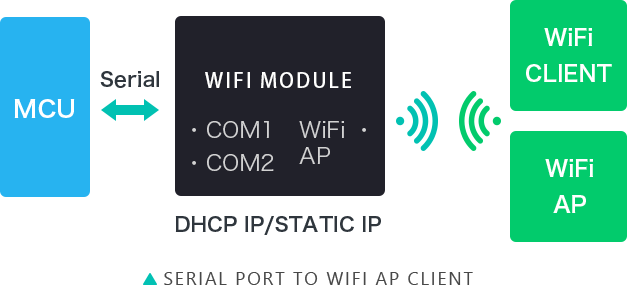
·In this mode, WiFi enabled works in AP+STA mode, that is, the module is connected to the superior WiFi to access the network as a STA, and also acts as AP for other devices to access。
·WiFi STA It can be configured as a dynamic IP address (DHCP) or a static IP address(STATIC)。
·In this mode, the WiFi device can connect to the module AP and become the device under the WiFi local area network。
·Ethernet ETH0-4 functions as a LAN port. Devices under EHTLAN and WiFi AP are on the same LAN, and the DHCP server is on by default。
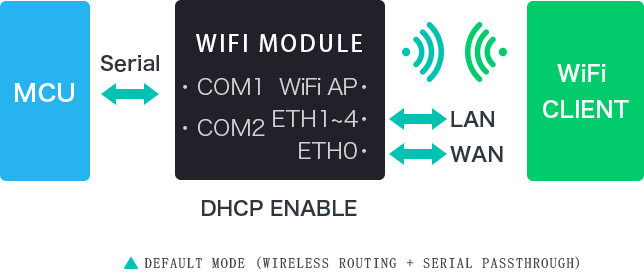
·In this mode, WiFi enabled, working in AP mode, Ethernet functional enabled,ETH0 as WAN, eth1-4 as LAN。
·In this mode, the WiFi device can be connected to the module and become the device under the WiFi local area network. WAN - end default dynamic IP address mode.
LAN and WiFi are the same LAN, and DHCP server is on by default。
Serial port to wired or wireless bridge
1.The serial port is connected by a wire bridge
In this mode, the module is connected to the superior router via the ETH network port (any ETH network port),
and the module and other devices connected under the module (ETH network port or AP of the module) are bridged to the superior route, that is, the device connected to
the module is the same as directly connected to the superior router
In bridge mode, the DHCP server is invalid and all DHCP requests will be forwarded to the superior route. Therefore, the device under the connection module can only get the correct IP address after the module is connected to the superior route through the network cable. You must set up a LAN with a valid IP address under the superior router to the module
IP, and set LANGateway IP as the IP of the superior router, so that the module can pass through normally; The AP hotspot function of the module can be switched on and off through the AP Enable configuration。
2.Serial port to wireless bridge
In this mode, the module is connected to the superior router via WiFi STA, and the module and other devices connected under the module (ETH network port or AP of the module) will be bridged to the superior route, that is, the device connected to the module is the same as directly connected to the superior router。
In bridge mode, the DHCP server is invalid and all DHCP requests will be forwarded to the superior route. Therefore, the device under the connection module can only get the correct IP address
after the module is connected to the superior route through the network cable. You must set up a LAN with a valid IP address under the superior router to the module
IP, and set LANGateway IP as the IP of the superior router, so that the module can pass through normally. The AP hotspot function of the module can be switched on and off through
the AP Enable configuration。
Common Problem
COMMON PROBLEM
Question 1: Where can the module product information be downloaded?
After placing an order, you can leave an email address to the customer service or directly visit the official website of Hailinke Electronic, www.hlktech.com and click
"Product Center" to download the corresponding product information
Question 2: Which pins does the module need to be connected to start?
Connect 5V and GND and you can start normally. If other pins are needed, you can connect them according to the use needs。
Question 2: Which pins does the module need to be connected to start?
Connect 5V and GND and you can start normally. If other pins are needed, you can connect them according to the use needs。
Question 3: How do modules restore factory Settings?
Two buttons, ES0 and RESET, are pressed on the bottom plate for more than 6 seconds, and the factory Settings can be restored. Pin 13 and 43 without the bottom plate module are grounded for more than 6 seconds。
Question 4: How does the module passthrough version enter AT instruction mode?
Long press the bottom plate RESET for 1 second to enter AT command mode, or pull down pin 42 of the module for 1 second。
Question 5: The module acts as the client mode, disconnects the superior route or disconnects, whether the server will reconnect?
It takes about 10 seconds to reconnect。








 hlk-rm08k(Pin version)
hlk-rm08k(Pin version) hlk-rm08k(The patch version)
hlk-rm08k(The patch version)









 Official mall
Official mall
 Taobao shop
Taobao shop






